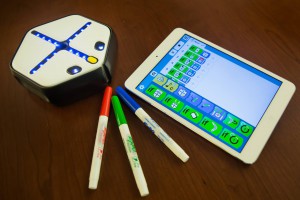A new educational robot developed by engineers at Harvard University’s Wyss Institute is changing the way students learn to code.
Root, a small hexagonal bot, magnetically glides across the vertical surface of a whiteboard. Students use the programming app Square to write code and tell Root what to do. Square allows students and coders of different ages and abilities to create code. Elementary students can use a simple block-based graphical environment, while older students can learn traditional text-based coding. Students can toggle between the different levels, allowing them to transition easily to more advanced coding and eventually working with JavaScript.
 Root can draw, erase and respond to lines drawn on the whiteboard. Root is also equipped with 15 multicolored LEDs which students can program and plays musical notes to show it’s mood and personality. Root is designed to fit in every classroom, using the whiteboard already equipped at the front of the room. The goal is to empower the next generation of coders and promote STEM fields in schools, making STEM practical, fun and interactive. Students can program Root to play games or to simply erase the board at the end of class, providing a real life example of coding in the classroom.
Root can draw, erase and respond to lines drawn on the whiteboard. Root is also equipped with 15 multicolored LEDs which students can program and plays musical notes to show it’s mood and personality. Root is designed to fit in every classroom, using the whiteboard already equipped at the front of the room. The goal is to empower the next generation of coders and promote STEM fields in schools, making STEM practical, fun and interactive. Students can program Root to play games or to simply erase the board at the end of class, providing a real life example of coding in the classroom.
The Wyss team is working on a curriculum to go with Root in the classroom. The robot will be available for schools to purchase next year for about $200 each. Root doesn’t require any special setup and teachers can become coding instructors without any training.
Interested in learning more about coding? Take our quick course “Careers in Coding“
